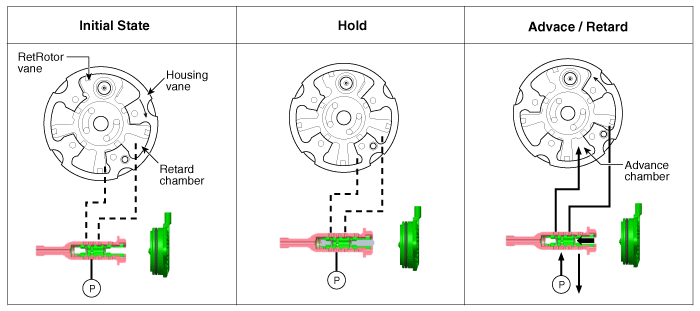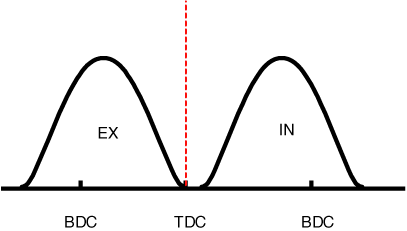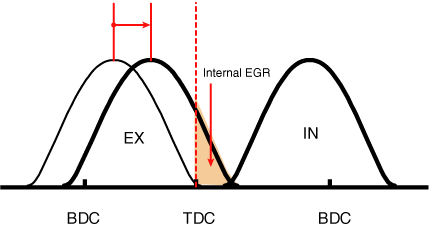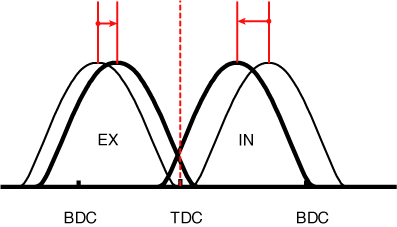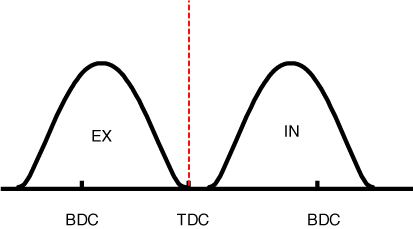Hyundai Santa Fe: Exhaust Emission Control System / CVVT (Continuously Variable Valve Timing) System. Description and operation
Hyundai Santa Fe (TM) 2019-2025 Service Manual / Emission Control System / Exhaust Emission Control System / CVVT (Continuously Variable Valve Timing) System. Description and operation
| Description |
Continuous Variable Valve Timing (CVVT) system advances or retards the valve
timing of the intake and exhaust valve in accordance with the ECM control signal
which is calculated by the engine speed and load.
By controlling CVVT, the valve over-lap or under-lap occurs, which makes better
fuel economy and reduces exhaust gases (NOx, HC) and improves engine performance
through reduction of pumping loss, internal EGR effect, improvement of combustion
stability, improvement of volumetric efficiency, and increase of expansion work.
This system consist of
| – |
the CVVT Oil Control Valve (OCV) which supplies the engine oil to the
cam phaser or runs out the engine oil from the cam phaser in accordance
with the ECM PWM (Pulse With Modulation) control signal,
|
| – |
the CVVT Oil Temperature Sensor (OTS) which measures the engine oil
temperature,
|
| – |
and the Cam Phaser which varies the cam phase by using the hydraulic
force of the engine oil.
|
The engine oil getting out of the CVVT oil control valve varies the cam phase
in the direction (Intake Advance/Exhaust Retard) or opposite direction (Intake
Retard/Exhaust Advance) of the engine rotation by rotating the rotor connected
with the camshaft inside the cam phaser.
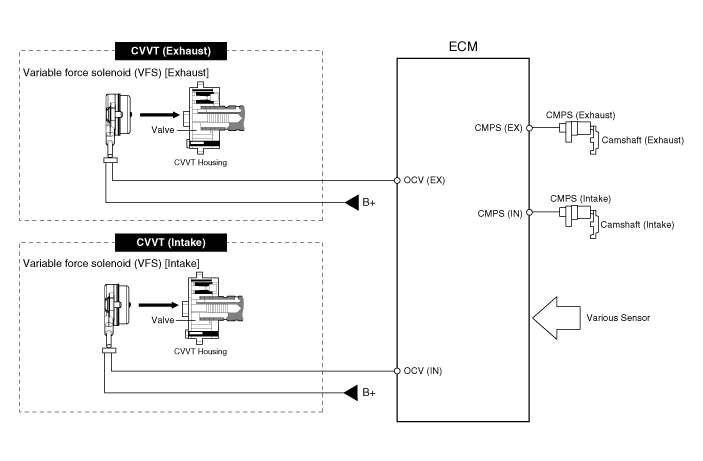
| Operation Principle |
The CVVT has the mechanism rotating the rotor vane with hydraulic force generated
by the engine oil supplied to the advance or retard chamber in accordance with
the CVVT oil control valve control.
|
| [CVVT System Mode] |
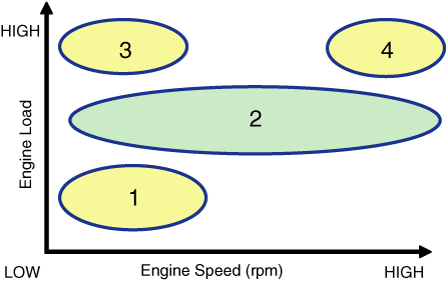
|
(1) Low Speed / Low Load |
(2) Part Load |
|
|
|
|
(3) Low Speed / High Load |
(4) High Speed / High Load |
|
|
|
|
Driving Condition |
Exhaust Valve |
Intake Valve |
||
|
Valve Timing |
Effect |
Valve Timing |
Effect |
|
|
(1) Low Speed /Low Load |
Completely Advance |
* Valve Under-lap * Improvement of combustion stability |
Completely Retard |
* Valve Under-lap * Improvement of combustion stability |
|
(2) Part Load |
Retard |
* Increase of expansion work * Reduction of pumping loss * Reduction of HC |
Retard |
* Reduction of pumping loss |
|
(3) Low Speed /High Load |
Retard |
* Increase of expansion work |
Advance |
* Prevention of intake back flow (Improvement of volumetric efficiency) |
|
(4) High Speed /High Load |
Advance |
* Reduction of pumping loss |
Retard |
* Improvement of volumetric efficiency |
 Catalytic Converter. Repair procedures
Catalytic Converter. Repair procedures
Removal
[Catalytic Converter (WCC)]
1.
Remove the exhaust manifold.
(Refer to Engine Mechanical System - "Exhaust Manifold")
[Catalytic Converter (UCC)]
1...
Other information:
Hyundai Santa Fe (TM) 2019-2025 Owner's Manual: Engine oil pressure warning light. Low fuel level warning light
Engine oil pressure warning light This warning light illuminates: When the engine oil pressure is low. If the engine oil pressure is low: 1. Drive carefully to the nearest safe location and stop your vehicle. 2. Turn the engine off and check the engine oil level (For more details, refer to “Engine Oil” section in chapter 9)...
Hyundai Santa Fe (TM) 2019-2025 Service Manual: Parking Collision-Avoidance Assist (PCA). Repair procedures
Removal Parking Collision-Avoidance Assist (PCA) Unit 1. Disconnect the negative (-) battery terminal. 2. Remove the ADAS PRK Unit. (Refer to Advanced Driver Assistance System (ADAS) - "Driver Parking Assistance System") Parking Collision-Avoidance Assist (PCA) Ultrasonic sensor 1...
Categories
- Manuals Home
- 4th Generation Santa Fe Owners Manual
- 4th Generation Santa Fe Service Manual
- Child-protector rear door locks
- Troubleshooting
- Instrument panel overview
- New on site
- Most important about car
Electric Power Steering (EPS) warning light. Charging system warning light
Electric Power Steering (EPS) warning light
.png)
This warning light illuminates:
When you set the ignition switch or the Engine Start/Stop button to the ON position.- The electric power steering warning light illuminates for about 3 seconds and then goes off. Whenever there is a malfunction with the electric power steering.
If this occurs, have the vehicle inspected by an authorized HYUNDAI dealer.
Copyright © 2025 www.hsafe4.com


